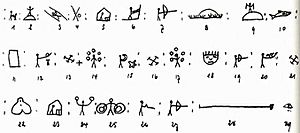Uyaquq facts for kids
Uyaquq (also known as Uyaquk or Uyakoq) was a special Yup'ik man from Alaska. He lived from about 1860 to 1924. He is famous for inventing a way to write his native language, Central Alaskan Yup'ik (also called Yugtun). Even though he couldn't read or write as an adult, he created a writing system and translated parts of the Bible in just five years!
Contents
Uyaquq's Early Life
Uyaquq was born around the 1860s in central Alaska. His family lived near the Kuskokwim River. His family members were shamans, who were traditional spiritual leaders. Uyaquq himself became a shaman when he was a young man.
Later, his father decided to become a Christian. After that, Uyaquq also converted to Christianity. While his father joined the Russian Orthodox Church, Uyaquq became a leader and missionary for the Moravian Church in Alaska. Some English speakers called him "Helper Neck" because his name, Uyaquq, means "Neck" in English.
A Dedicated Missionary
As a missionary, Uyaquq traveled to many Yup'ik villages. He helped many people in the lower Kuskokwim River valley learn about Christianity. People said he had a very kind personality. They also said he was a great speaker who could explain things very well.
How Uyaquq Invented Writing
Uyaquq was very curious about how English-speaking missionaries could say the same Bible stories word for word every time. He soon learned they did this by reading from written books. This idea of writing fascinated Uyaquq.

According to his family, Uyaquq got the idea for his first writing system in a dream. This first system used pictures, like hieroglyphics, to represent words or ideas in his language, Yugtun.
A Moravian missionary named Reverend John Hinz was amazed when he heard about Uyaquq's invention. Reverend Hinz was a linguist, someone who studies languages. He invited Uyaquq to the Bethel mission house to continue his work. People said Uyaquq wrote constantly during the trip, putting as many Bible stories as he could into his new script without stopping to sleep.
Reverend Hinz and other missionaries helped Uyaquq by telling him scriptures. However, Uyaquq chose not to learn English reading or writing. He believed that learning English might make him lose his Yup'ik identity.
The Script Evolves
Over the next five years, Uyaquq's Yugtun script changed a lot. It started with pictures (pictographs) and slowly became a syllabary. A syllabary is a writing system where each symbol stands for a whole syllable (like "ba" or "ko"), not just a single letter.
Uyaquq realized his picture-based writing was good for remembering things. But it wasn't exact enough to say the same passage perfectly every time. He then figured out what a syllable was. His script changed through five different stages. Each time, he created a new symbol for each syllable in the Yup'ik language.
Uyaquq kept detailed notebooks about each step of his script's development. He taught his new writing system to his missionary helpers. They then used it in their church work to share stories and teachings.
Uyaquq's Legacy
Today, most Yup'ik people use a writing system based on the Roman alphabet. This system was developed by Reverend Hinz and later updated by the University of Alaska. However, Uyaquq's unique writing system is still very important.
Scientists have studied Uyaquq's work because it shows how ancient writing systems might have developed. Many old languages, like Chinese and Egyptian, went from not having writing to using pictures, and then to more complex systems. Uyaquq's journey from not being able to read to creating a full syllabary in just five years is like a fast-forward version of this process.
Researchers, like Dr. Alfred Schmitt in the 1930s, have studied Uyaquq's notebooks and the writings of those who watched him work. His story helps us understand how writing itself came to be.

